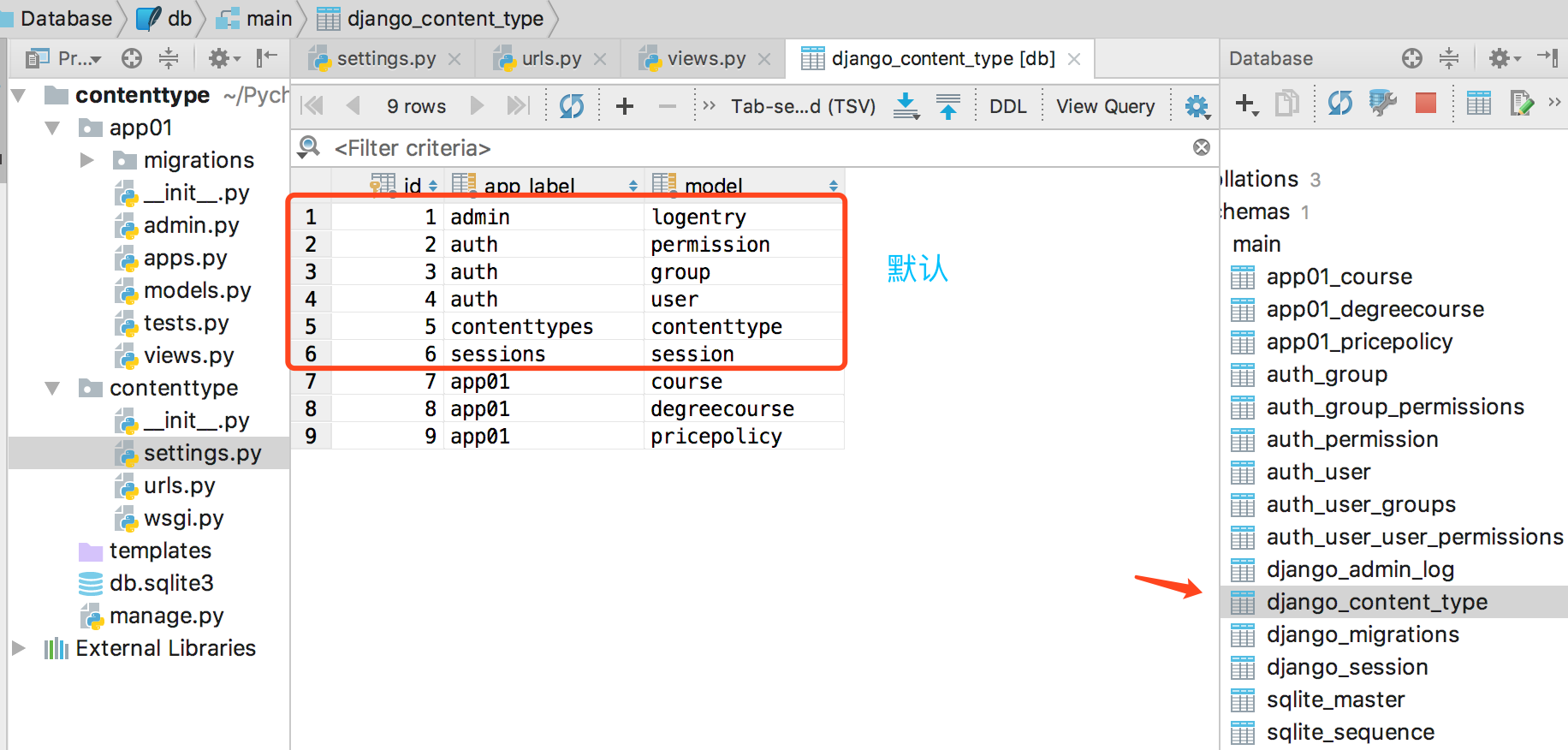django内置组件——ContentTypes
一、什么是Django ContentTypes?
Django ContentTypes是由Django框架提供的一个核心功能,它对当前项目中所有基于Django驱动的model提供了更高层次的抽象接口。主要用来创建模型间的通用关系(generic relation)。
进一步了解ContentTypes可以直接查阅以下这两个链接:
- Django official documentation:The contenttypes framework
- stackoverflow: How exactly do Django content types work?
二、Django ContentTypes做了什么?
当创建一个django项目时,可以看到在默认的INSTALL_APPS已经包含了django.contrib.contenttypes。
1 2 3 4 5 6 7 8 9 10 11 | # Application definitionINSTALLED_APPS = [ 'django.contrib.admin', 'django.contrib.auth', 'django.contrib.contenttypes', 'django.contrib.sessions', 'django.contrib.messages', 'django.contrib.staticfiles', 'app01.apps.App01Config',] |
注意:django.contrib.contenttypes是在django.contrib.auth之后,这是因为auth中的permission系统是根据contenttypes来实现的。
导入contenttypes组件:
1 | from django.contrib.contenttypes.models import ContentType |
查看django.contrib.contenttypes.models.ContentType类的内容:
1 2 3 4 5 6 7 8 9 10 11 12 13 | class ContentType(models.Model): app_label = models.CharField(max_length=100) model = models.CharField(_('python model class name'), max_length=100) objects = ContentTypeManager() class Meta: verbose_name = _('content type') verbose_name_plural = _('content types') db_table = 'django_content_type' unique_together = (('app_label', 'model'),) def __str__(self): return self.name |
可以看到ContentType就是一个简单的django model,而且它在数据库中的表的名字为django_content_type。
在第一次对Django的model进行migrate之后,就可以发现在数据库中出现了一张默认生成的名为django_content_type的表。
如果没有建立任何的model,默认django_content_type是前六项:

django_content_type记录了当前的Django项目中所有model所属的app(即app_label属性)以及model的名字(即model属性)。
django_content_type并不只是记录属性这么简单.了contenttypes是对model的一次封装,因此可以通过contenttypes动态的访问model类型,而不需要每次import具体的model类型。
1、ContentType实例提供的接口
- ContentType.model_class()
获取当前ContentType类型所代表的模型类
- ContentType.get_object_for_this_type()
使用当前ContentType类型所代表的模型类做一次get查询
2、ContentType管理器(manager)提供的j接口
- ContentType.objects.get_for_id()
- 通过id寻找ContentType类型,这个跟传统的get方法的区别就是它跟get_for_model共享一个缓存,因此更为推荐。
- ContentType.objects.get_for_model()
- 通过model或者model的实例来寻找ContentType类型
三、Django ContentTypes框架使用场景
1、设计模型(创建表结构)
假设我们创建如下模型,里面包含学位课程、专题课程、价格策略。
价格策略既可以是专题课程的价格策略,也可以是学位课程的价格策略。需要在pricepolicy对象里添加非常多的ForeignKey。示例如下所示:
class Food(models.Model): """ id title 1 面包 2 牛奶 """ title = models.CharField(max_length=32) # 不会生成字段 只用于反向查询 coupons = GenericRelation(to="Coupon") class Fruit(models.Model): """ id title 1 苹果 2 香蕉 """ title = models.CharField(max_length=32) # 如果有40张表,则每一个都要建立外键关系 class Coupon(models.Model): """ id title food_id fruit_id 1 面包九五折 1 null 2 香蕉满10元减5元 null 2 """ title = models.CharField(max_length=32) food = models.ForeignKey(to="Food") fruit = models.ForeignKey(to="Fruit")
这样做很傻,会造成代码重复和字段浪费。有一种优化的方案是:用两个字段去定位对象不用去创建多个外键关系。
# 方法二:用两个字段去定位对象不用去创建多个外键关系 class Coupon(models.Model): """ id title table_id object_id(对应表对应对象的ID) 1 面包九五折 1 1 2 香蕉满10元减5元 2 2 """ title = models.CharField(max_length=32) table = models.ForeignKey(to="Table") # 与table表建立外键关系 object_id = models.IntegerField() # 由object_id定位到表中的某一个对象,但没有建立外键关系 class Table(models.Model): """ id app_name table_name 1 demo food 2 demo fruit """ app_name = models.CharField(max_length=32) table_name = models.CharField(max_length=32)
最好的方式是,只有当你需要对某个对象或模型进行评论时,才创建pricepolicy与那个模型的关系。示例如下所示:
# 方法三:基于ContentTypes创建表结构 class Coupon(models.Model): title = models.CharField(max_length=32) # 优惠券名称 # 第一步:与ContentType表绑定外键关系 content_type = models.ForeignKey(to=ContentType, on_delete=None) # 第二步:建立对象id object_id = models.IntegerField() # 第三步:content_type和object_id绑定外键关系 content_object = GenericForeignKey("content_type", "object_id")
学位课程、专题课程、价格策略基于django contenttypes创建表结构如下所示:
1 2 3 4 5 6 7 8 9 10 11 12 13 14 15 16 17 18 19 20 21 22 23 24 25 26 27 28 29 30 31 32 33 34 35 36 37 38 39 40 41 42 43 | from django.db import modelsfrom django.contrib.contenttypes.models import ContentTypefrom django.contrib.contenttypes.fields import GenericForeignKey, GenericRelationclass DegreeCourse(models.Model): """学位课程""" name = models.CharField(max_length=128, unique=True) course_img = models.CharField(max_length=255, verbose_name="缩略图") brief = models.TextField(verbose_name="学位课程简介", )class Course(models.Model): """专题课程""" name = models.CharField(max_length=128, unique=True) course_img = models.CharField(max_length=255) # 不会在数据库生成列,只用于帮助你进行查询 policy_list = GenericRelation("PricePolicy")class PricePolicy(models.Model): """价格策略表""" content_type = models.ForeignKey(ContentType, on_delete=models.CASCADE) # 关联course or degree_course object_id = models.PositiveIntegerField() # 正整数PositiveInteger # GenericForeignKey不会在数据库生成列,只用于帮助你进行添加和查询 content_object = GenericForeignKey('content_type', 'object_id') # 将两个字段放在这个对象中 # 周期 valid_period_choices = ( (1, '1天'), (3, '3天'), (7, '1周'), (14, '2周'), (30, '1个月'), (60, '2个月'), (90, '3个月'), (180, '6个月'), (210, '12个月'), (540, '18个月'), (720, '24个月'), ) # 价格 valid_period = models.SmallIntegerField(choices=valid_period_choices) price = models.FloatField() |
(1)GenericForeignKey
Django ContentType提供了一种GenericForeignKey的类型,通过这种类型可以指定content_object。
GenericForeignKey不会在数据库生成列,只用于帮助你进行添加和查询。
(2)GenericRelation
GenericRelation不会在数据库生成列,只用于帮助你进行查询。
(3)pricepolicy里有三个重要字段
-
content_type: 内容类型,代表了模型的名字(比如Course,DegreeCourse)
-
object_id: 传入对象的id
-
content_object: 传入的实例化对象,其包含两个属性content_type和object_id。
2、视图操作
(1)在价格策略表(pricepolicy)中添加数据
1 2 3 4 5 6 7 8 9 10 11 12 13 14 15 16 17 18 | from django.shortcuts import render, HttpResponsefrom app01 import modelsfrom django.contrib.contenttypes.models import ContentTypedef test(request):<br> # 方法一: models.PricePolicy.objects.create( valid_period=7, price=6.6, content_type=ContentType.objects.get(model="course"), object_id=1 ) # 方法二: models.PricePolicy.objects.create( valid_period=14, price=9.9, content_object=models.Course.objects.get(id=1) # 'content_type', 'object_id' ) return HttpResponse("...") |
访问http://127.0.0.1:8000/test/ 后,查看价格策略表保存的数据:

(2)根据某个价格策略对象,找到其对应的表和数据
这里以查看管理课程名称为例:
1 2 3 4 5 6 7 8 9 | from django.shortcuts import render, HttpResponsefrom app01 import modelsfrom django.contrib.contenttypes.models import ContentTypedef test(request): price = models.PricePolicy.objects.get(id=2) print(price.content_object.name) # 21天入门python 即自动帮忙找到对应的对象 return HttpResponse("...") |
(3)找到某个课程关联的所有价格策略
注意这里需要利用到GenericRelation。
1 2 3 4 5 6 7 8 9 | from django.shortcuts import render, HttpResponsefrom app01 import modelsfrom django.contrib.contenttypes.models import ContentTypedef test(request): obj = models.Course.objects.get(id=1) print(obj.policy_list.all()) # <QuerySet [<PricePolicy: PricePolicy object (1)>, <PricePolicy: PricePolicy object (2)>]> return HttpResponse("...") |
查询结果是一个QuerySet对象,如果想让查询结果更加清楚:
1 2 3 4 5 6 7 8 9 10 11 12 13 14 | from django.shortcuts import render, HttpResponsefrom app01 import modelsfrom django.contrib.contenttypes.models import ContentTypedef test(request): obj = models.Course.objects.get(id=1) for item in obj.policy_list.all(): print(item.id, item.valid_period, item.price) """ 1 7 6.6 2 14 9.9 """ return HttpResponse("...") |
四、总结ContentType
如果一张表与N张表动态地要创建Foreign Key关系,如果创建 Foreign key 将生成很多列,这样很多都是空的,造成严重浪费空间。只要是一张表要和多张表建立外键关系的情况,都可以考虑使用django的ContentType组件来帮助实现,以简化表结构的设计。
ContentType组件的作用:可以通过两个字段(GenericForeignKey, GenericRelation),在保证列数不变的情况下,让一张表和N张表做Foreign Key关系。





【推荐】国内首个AI IDE,深度理解中文开发场景,立即下载体验Trae
【推荐】编程新体验,更懂你的AI,立即体验豆包MarsCode编程助手
【推荐】抖音旗下AI助手豆包,你的智能百科全书,全免费不限次数
【推荐】轻量又高性能的 SSH 工具 IShell:AI 加持,快人一步
· 如何编写易于单元测试的代码
· 10年+ .NET Coder 心语,封装的思维:从隐藏、稳定开始理解其本质意义
· .NET Core 中如何实现缓存的预热?
· 从 HTTP 原因短语缺失研究 HTTP/2 和 HTTP/3 的设计差异
· AI与.NET技术实操系列:向量存储与相似性搜索在 .NET 中的实现
· 10年+ .NET Coder 心语 ── 封装的思维:从隐藏、稳定开始理解其本质意义
· 地球OL攻略 —— 某应届生求职总结
· 周边上新:园子的第一款马克杯温暖上架
· Open-Sora 2.0 重磅开源!
· 提示词工程——AI应用必不可少的技术